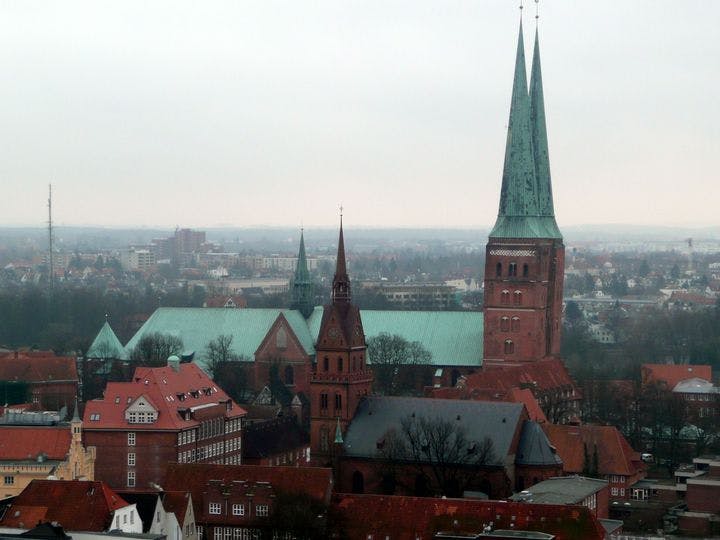Fall 2008
Medieval Protectionism
– The Wilson Quarterly
The German cities of Lübeck and Hamburg took different approaches to outside trade; one faded into insignificance, while the other became Europe's third most important trading center.
Its ancient name means “lovely,” and the German port city of Lübeck in 1400 was one of the glories of Europe and a leading merchant trading center. In that distant era, as Europe recovered from the devastation of the Black Plague, Lübeck and its neighbor, Hamburg, had roughly similar social, economic, and religious profiles, writes Erik Lindberg, a historian at Uppsala University in Sweden. They could have been twin cities: Lübeck connected to the Baltic Sea via the Trave River and Hamburg to the North Sea via the Elbe. Their divergent fates illustrate the perils of extreme protectionism.
At the dawn of the early modern period, the two cities veered in opposite political directions. In the face of increasing Baltic Sea competition from upstart traders from London and Amsterdam, Lübeck chose to protect its powerful landowners and leading merchant guild by prohibiting importers from selling copper, furs, and grain to anybody other than a Lübeck merchant. Hamburg, by contrast, encouraged trade with Dutch, Flemish, and English merchants, and even a score of Portuguese Jews were invited to move in.
The copper-trading capital of Northern Europe, Lübeck began in 1607 to rigorously enforce a 12th-century imperial privilege that allowed it to prohibit “transit” trade. Commodities coming from Sweden had to be resold and reloaded for transport down the 40-odd miles of the Stecknitz Canal and connected waterways to Hamburg for shipment to the Atlantic, or inland along the Elbe River. This “right of staple” medieval privilege was considered a cornerstone of the city’s wealth. It was rigorously guarded by the five or six aristocratic families who dominated the ruling council and the approximately 20 merchant families that controlled trade. Growth in the number of burghers was severely restricted to protect the income of the incumbents. For nearly two centuries Lübeck’s social and political structure remained frozen as cities elsewhere in Europe changed and grew.
The fortunes of Lübeck and Hamburg diverged, with the former fading into near insignificance and the latter becoming Europe’s third most important trading center.
This was the period of the Reformation, and as it swept through German cities such as Lübeck, the elite managed to stay in power even as Catholic institutions were abolished. In Hamburg, however, the religious upheaval led to the passage of the “Long Ordinance” constitution in 1562, which guaranteed merchants substantial clout in city affairs and thus ensured that medieval guilds would not feel obliged to maintain a united front against the aristocrats. Aspiring merchants established the Hamburg Exchange, a market that brought in foreign traders and opened up business opportunities.
The presence in Hamburg of so many “merchant strangers” with knowledge and important contacts generated a commercial infrastructure. With 17th-century Europe convulsed by the Dutch revolt against Spain, Philip II’s annexation of Portugal (with its accompanying threats to the country’s Jewish merchant families), and King Louis XIV’s expulsion of Protestants from France, the relative freedom of religion and commerce Hamburg offered attracted refugees and entrepreneurs. And when the English parliament passed the Navigation Acts in the mid-17th century to protect England’s national shipping from competition, Hamburg was given a lucrative exemption—a payoff for its earlier open door to London.
The fortunes of the two German cities diverged, with Lübeck fading into near insignificance and Hamburg becoming the third most important trading center on the continent. In the absence of reliable trade statistics and other business data, population serves as the best measure of relative economic development, Lindberg says. In 1400 Lübeck and Hamburg were approximately the same size, and by 1700 Lübeck was still a city of around 25,000. Hamburg’s population was roughly 75,000.
* * *
THE SOURCE: “The Rise of Hamburg as a Global Marketplace in the 17th Century: A Comparative Political Economy Perspective” by Erik Lindberg, in Comparative Studies in Society and History, July 2008.
Photo courtesy of Flickr/Reading Tom
